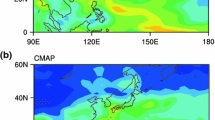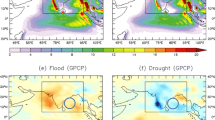Abstract
The study mainly investigates sea surface temperature (SST) and outgoing longwave radiation (OLR) relationships in coupled climate model. To support the analysis, high-level cloud and OLR relationship is also investigated. High-level cloud and OLR relationship depicts significant negative correlation over the entire monsoon regime. Coupled climate model is able to produce the same. SST and OLR relationship in observation also depicts significant negative relationship, in particular, over the Equatorial Eastern Indian Ocean (EIO) region. Climate Forecast System version 2 (CFSv2) is able to portray the negative relationship over EIO region; however, it is underestimated as compared to observation. Significant negative correlations elucidate that local SSTs regulate the convection and further it initiates Bjerknes feedback in the central Indian Ocean. It connotes that SST anomalies during monsoon period tend to be determined by oceanic forcing. The heat content of the coastal Bay of Bengal shows highest response to EIO SST by a lag of 1 month. It suggests that the coastal region of the Bay of Bengal is marked by coastally trapped Kelvin waves, which might have come from EIO at a time lag of 1 month. Sea surface height anomalies, depth at 20 °C isotherms and depth at 26 isotherms also supports the above hypothesis. Composite analysis based on EIO index and coupled climate model sensitivity experiments also suggest that the coastal Bay of Bengal region is marked by coastally trapped Kelvin waves, which are propagated from EIO at a time lag of 1 month. Thus, SST and OLR relationship pinpoints that the Bay of Bengal OLR (convection) is governed by local ocean–atmospheric coupling, which is influenced by the delayed response from EIO brought forward through oceanic planetary waves at a lag of 1 month. These results have utmost predictive value for seasonal and extended range forecasting. Thus, OLR and SST relationship can constitute a pivotal role in investigating the atmosphere–ocean interaction.














Similar content being viewed by others
References
Adler RF, Huffman GJ, Chang A, Ferraro R, Xie P, Janowiak J, Rudolf B, Schneider U, Curtis S, Bolvin D, Gruber A, Susskind J, Arkin P, Nelkin E (2003) The version 2 global precipitation climatology project (GPCP) monthly precipitation analysis (1979–present). J Hydrol Meteorol 4:1147–1167
Bjerknes J (1969) Atmospheric teleconnections from the equatorial Pacific. Mon Weather Rev 97:163–172
Bombardi RJ, Schneider EK, Marx L, Halder S, Singh B, Tawfik AB, Dirmeyer PA, Kinter JL (2015) Improvements in the representation of the Indian summer monsoon in the NCEP climate forecast system version 2. Clim Dyn 45:2485–2498
Bony S, Lau KM, Sud C (1997) Sea surface temperature and large-scale circulation influences on tropical greenhouse effect and cloud radiative forcing. J Clim 10:2055–2077
Chaudhari HS, Shinde MA, Oh JH (2010) Understanding of anomalous Indian summer monsoon rainfall of 2002 and 1994. Quat Int 213:20–32
Chaudhari HS, Pokhrel S, Saha SK, Dhakate A, Yadav RK, Salunke K, Mahapatra S, Sabeerali CT, Rao SA (2013a) Model biases in long coupled runs of NCEP CFS in the context of Indian summer monsoon. Int J Climatol 33:1057–1069
Chaudhari HS, Pokhrel S, Mohanty S, Saha SK (2013b) Seasonal prediction of Indian summer monsoon in NCEP coupled and uncoupled model. Theor Appl Climatol 114:459–477
Chaudhari HS, Pokhrel S, Saha SK, Dhakate A, Hazra A (2015) Improved depiction of Indian summer monsoon in latest high resolution NCEP climate forecast system reanalysis. Int J Climatol 35:3102–3119
Chaudhari HS, Pokhrel S, Kulkani A, Hazra A, Saha SK (2016a) Clouds-SST relationship and interannual variability modes of Indian summer monsoon in the context of clouds and SSTs: observational and modelling aspects. Int J Climatol. doi:10.1002/joc.4664
Chaudhari HS, Hazra A, Saha SK, Dhakate A, Pokhrel S (2016b) Indian summer monsoon simulations with CFSv2: a microphysics perspective. Theor Appl Climatol 125:253–269
Chaudhari HS, Pokhrel S, Rahman H, Dhakate A, Saha SK, Pentakota S, Gairola RM (2016c) Influence of upper ocean on Indian summer monsoon rainfall: studies by observation and NCEP Climate Forecast System (CFSv2). Theor Appl Climatol 125:413–426
Clark CO, Cole JE, Webster PJ (2000) Indian ocean SST and Indian summer rainfall: predictive relationships and their decadal variability. J Clim 13:2503–2519
Dee DP, Uppala SM, Simmons AJ, Berrisford P, Poli P, Kobayashi S, Andrae U, Balmaseda MA, Balsamo G, Bauer P, Bechtold P, Beljaars ACM, Van de Berg L, Bidlot J, Bormann N, Delsol C, Dragani R, Fuentes M, Geer AJ, Haimberger L, Healy SB, Hersbach H, Hólm EV, Isaksen L, Kållberg P, Köhler M, Matricardi M, McNally AP, Monge-Sanz BM, Morcrette JJ, Park BK, Peubey C, Rosnay PD, Tavolato C, Thépaut JN, Vitart F (2011) The ERA-Interim reanalysis: configuration and performance of the data assimilation system. Q J R Meteorol Soc 137:553–597
Delsole T, Shukla J (2010) Model fidelity versus skill in seasonal forecasting. J Clim 23:4794–4806
Gadgil S, Joseph PV, Joshi NV (1984) Ocean–atmosphere coupling over monsoon regions. Nature 312:141–143
Griffies SM, Harrison MJ, Pacanowski RC, Rosati A (2004) A technical guide to MOM4. GFDL ocean group technical report No. 5, NOAA/Geophysical Fluid Dynamics Laboratory, Washington, DC
Hazra A, Chaudhari HS, Rao SA, Goswami BN, Dhakate A, Pokhrel S, Saha SK (2015) Impact of revised cloud microphysical scheme in CFSv2 on the simulation of the Indian summer monsoon. Int J Climatol 35:4738–4755
Hazra A, Chaudhari HS, Dhakate A (2016) Evaluation of cloud properties in the NCEP CFSv2 model and its linkage with Indian summer monsoon. Theor Appl Climatol 124:31–41
Joseph PV, Sooraj KP, Babu CA, Sabin TP (2005) A cold pool in the Bay of Bengal and its interaction with the active-break cycle of the monsoon. CLIVAR Exch 34(10):10–12
Kohyama T, Tozuka T (2016) Seasonal variability of the relationship between SST and OLR in the Indian Ocean and its implications for initialization in a CGCM with SST nudging. J Oceanogr 72:327–337
Kripalani RH, Singh SV, Arkin PA (1991) Large scale features of rainfall and outgoing long wave radiation over India and adjoining regions. Contrib Atmos Phys 64:159–168
Krishnamurti TN, Bedi HS, Subramaniam M (1989) The summer monsoon of 1987. J Clim 2:321–340
Kug JS, Kang IS, Choi DH (2008) Seasonal climate predictability with tier-one and tier-two prediction systems. Clim Dyn 31:403–416
Kumar KK, Hoerling M, Rajagopalan B (2005) Advancing dynamical prediction of Indian monsoon rainfall. Geophys Res Lett 32:L08704
Liebmann B, Smith CA (1996) Description of a complete (interpolated) outgoing longwave radiation dataset. Bull Am Meteorol Soc 77:1275–1277
Murakami T (1980) Empirical orthogonal function analysis of satellite observed outgoing long-wave radiation during summer. Mon Weather Rev 108:205–222
Pai DS, Rajeevan M (1998) Clouds and cloud radiative forcing over tropical Indian Ocean and their relationship with sea surface temperature. Curr Sci 75:372–381
Pokhrel S, Chaudhari HS, Saha SK, Dhakate A, Yadav RK, Salunke K, Mahapatra S, Rao SA (2012) ENSO, IOD and Indian Summer Monsoon in NCEP climate forecast system. Clim Dyn 39:2143–2165
Pokhrel S, Saha SK, Dhakate A, Rahman H, Chaudhari HS, Salunke K, Hazra A, Sujith K, Sikka DR (2016) Seasonal prediction of Indian summer monsoon rainfall in NCEP CFSv2: forecast and predictability error. Clim Dyn 46:2305–2326
Rajeevan M, Nanjundiah RS (2009) Coupled model simulations of twentieth century climate of the Indian summer monsoon. In: Mukunda N (ed) Current trends in science—platinum jubilee special. Indian Academy of Sciences, Bangalore, pp 537–567
Rajeevan M, Unnikrishnan CK, Preethi B (2012) Evaluation of the ENSEMBLES multi-model seasonal forecasts of Indian summer monsoon variability. Clim Dyn 38:2257–2274
Rao RR, Girish Kumar MS, Ravichandran M, Samala BK (2006) Observed mini-cold pool off the southern tip of India and its intrusion into the south central Bay of Bengal during summer monsoon season. Geophy Res Lett 33:L06607. doi:10.1029/2005GL025382
Rao RR, GirishKumar MS, Ravichandran M, Rao AR, Gopalakrishna VV, Thadathil P (2010) Interannual variability of Kelvin wave propagation in the wave guides of the equatorial Indian Ocean, the coastal Bay of Bengal and the southeastern Arabian Sea during 1993–2006. Deep Sea Res I 57:1–13
Reynolds RW, Rayner NA, Smith TM, Stokes DC, Wang W (2002) An improved in situ and satellite SST analysis for climate. J Clim 15:1609–1625
Saha S, Moorthi S, Pan HL, Wu X, Wang J, Nadiga S, Tripp P, Kistler R, Woollen J, Behringer D, Liu H, Stokes D, Grumbine R, Gayno G, Wang J, Hou YT, Chuang HY, Juang H-MH, Sela J, Iredell M, Treadon R, Kleist D, Delst PV, Keyser D, Derber J, Ek M, Meng J, Wei H, Yang R, Lord S, Dool HVD, Kumar A, Wang W, Long C, Chelliah M, Xue Y, Huang B, Schemm JK, Ebisuzaki W, Lin R, Xie P, Chen M, Zhou S, Higgins W, Zou CZ, Liu Q, Chen Y, Han Y, Cucurull L, Reynolds RW, Rutledge G, Goldberg M (2010) The NCEP climate forecast system reanalysis. Bull Am Meteorol Soc 91:1015–1057
Saha S, Moorthi S, Wu X, Wang J, Nadiga S, Tripp P, Behringer D, Hou YT, Chuang HY, Iredell M, Ek M, Meng J, Yang R, van den Mendez, Zhang H, Wang W, Chen M, Becker E (2014a) The NCEP climate forecast system version 2. J Clim 27:2185–2208
Saha SK, Pokhrel S, Chaudhari HS, Dhakate A, Shewale S, Sabeer Ali CT, Salunke K, Hazra A, Mahapatra S, Rao AS (2014b) Improved simulation of Indian summer monsoon in latest NCEP climate forecast system (CFSv2) free run. Int J Climatol 34:1628–1641
Saha SK, Pokhrel S, Salunke K, Dhakate A, Chaudhari HS, Rahman H, Sujith K, Hazra A, Sikka DR (2016) Potential predictability of Indian Summer Monsoon rainfall in NCEP CFSv2. J Adv Model Earth Syst. doi:10.1002/2015MS000542
Saji NH, Goswami BN, Vinayachandran PN, Yamagata T (1999) A dipole mode in the tropical Indian Ocean. Nature 401:360–363
Shukla J (1975) Effect of Arabian Sea Surface temperature anomaly on Indian summer monsoon: a numerical experiment with the GFDL model. J Atmos Sci 32:503–511
Sreenivas P, Gnanaseelan C, Prasad KVSR (2012) Influence of El Niño and Indian Ocean Dipole on sea level variability in the Bay of Bengal. Global Planetary Change 80–81:215–225
Stephens GL, Vane DG, Boain RJ, Mace GG, Sassen K, Wang Z, Illingworth AJ, O’Connor EJ, Rossow WB, Durden SL, Miller SD, Austin RT, Benedetti A, Mitrescu C (2002) The Cloudsat mission and A-train: a new dimension of space based observations of clouds and precipitation. Bull Am Meteorol Soc 83:1771–1790
Wang B, Ding Q, Fu X, Kang IS, Jin K, Shukla J, Doblas-Reyes F (2005) Fundamental challenge in simulation and prediction of summer monsoon rainfall. Geophys Res Lett 32:L15711. doi:10.1029/2005GL022734
Acknowledgements
Authors are thankful to the Director and Chief Program Scientist, IITM for providing encouragement to carry out this research work. IBM High Power Computing (HPC) System of IITM, Prithvi facility is also acknowledged. This research is a part of SAC SARAL-AltiKa (ocean–atmosphere coupled processes in Tropical Indian Ocean) project. Authors also thank anonymous reviewers and editor for their constructive comments and suggestions.
Author information
Authors and Affiliations
Corresponding author
Additional information
Responsible Editor: S. Hong.
Rights and permissions
About this article
Cite this article
Chaudhari, H.S., Hazra, A., Pokhrel, S. et al. SST and OLR relationship during Indian summer monsoon: a coupled climate modelling perspective. Meteorol Atmos Phys 130, 211–225 (2018). https://doi.org/10.1007/s00703-017-0514-0
Received:
Accepted:
Published:
Issue Date:
DOI: https://doi.org/10.1007/s00703-017-0514-0




